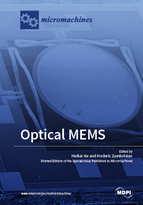Optical MEMS
A special issue of Micromachines (ISSN 2072-666X). This special issue belongs to the section "A:Physics".
Deadline for manuscript submissions: closed (31 March 2019) | Viewed by 67973
Special Issue Editors
Interests: MOEMS; micromirror arrays; MOEMS characterization; astronomical instrumentation; spectrographs; spectro-imagers; space optical instrumentation; universe observation; earth observation
Special Issues, Collections and Topics in MDPI journals
Interests: MEMS; CMOS-MEMS sensors; micromirrors; microactuators; piezoelectric MEMS microspeakers; pMUTs; photoacoustic microscopy; optical endomicroscopy
Special Issues, Collections and Topics in MDPI journals
Special Issue Information
Dear Colleagues,
Optical microelectromechanical systems (MEMS), microoptoelectromechanical systems (MOEMS), or optical microsystems, are devices or systems that interact with light through actuation or sensing at a micron or millimeter scale. Optical MEMS have had enormous commercial success in projectors, displays, and fiberoptic communications. The best known example is Texas Instruments’ digital micromirror devices (DMDs). The development of optical MEMS was impeded seriously by the Telecom Bubble in 2000. Fortunately, DMDs grew their market size even in that enconomy downturn. Meanwhile, in the last one and half decades, the optical MEMS market has been slowly but steadily recovering. During this time span, the major technological change was the shift of thin-film polysilicon microstructures to single-crystal-silicon microsructures. Especially in the last few years, cloud data centers demand large-port optical cross connects (OXCs), autonous driving looks for miniature LiDAR, and virtual reality/augumented reality (VR/AR) demands tiny optical scanners. This is a new wave of opportunities for optical MEMS. Furthermore, several research institutes around the world have been developing MOEMS devices for extreme applications (very fine tailoring of light beam in terms of phase, intensity, or wavelength) and/or extreme environments (vacuum, cryogenic temperatures) for many years. Accordingly, this Special Issue seeks to showcase research papers, short communications, and review articles that focus on (1) novel design, fabrication, control, and modeling of optical MEMS devices based on all kinds of actuation/sensing mechanisms; and (2) new developments of applying optical MEMS devices of any kind in consumer electronics, optical communications, industry, biology, medicine, agriculture, physics, astronomy, space, or defense.
Prof. Huikai Xie
Prof. Frederic Zamkotsian
Guest Editors
Manuscript Submission Information
Manuscripts should be submitted online at www.mdpi.com by registering and logging in to this website. Once you are registered, click here to go to the submission form. Manuscripts can be submitted until the deadline. All submissions that pass pre-check are peer-reviewed. Accepted papers will be published continuously in the journal (as soon as accepted) and will be listed together on the special issue website. Research articles, review articles as well as short communications are invited. For planned papers, a title and short abstract (about 100 words) can be sent to the Editorial Office for announcement on this website.
Submitted manuscripts should not have been published previously, nor be under consideration for publication elsewhere (except conference proceedings papers). All manuscripts are thoroughly refereed through a single-blind peer-review process. A guide for authors and other relevant information for submission of manuscripts is available on the Instructions for Authors page. Micromachines is an international peer-reviewed open access monthly journal published by MDPI.
Please visit the Instructions for Authors page before submitting a manuscript. The Article Processing Charge (APC) for publication in this open access journal is 2600 CHF (Swiss Francs). Submitted papers should be well formatted and use good English. Authors may use MDPI's English editing service prior to publication or during author revisions.
Keywords
- micromirrors
- microlenses
- tunable lenses
- metalenses
- microgratings
- microbolometers
- endomicroscopy
- microspectrometers
- beam steering
- optical phased arrays
- optical switches
- VOA
- micro-LiDAR
- OXC
- DMD
- optical MEMS sensors
Related Special Issues
- Optical MEMS, Volume II in Micromachines (17 articles)
- Optical MEMS, Volume III in Micromachines (8 articles)








